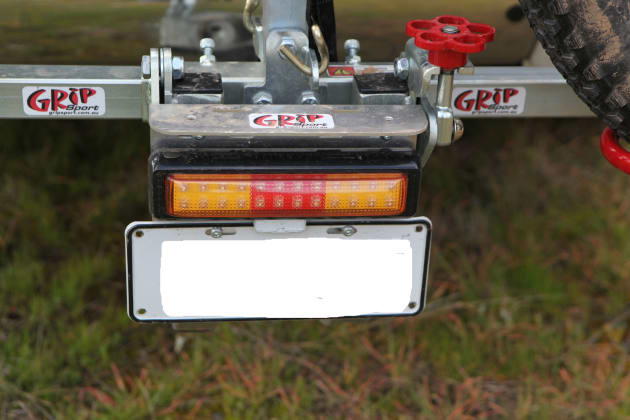Gripsport Hi-Ride Tilty Rack
GripSport has been making bike carriers for over a decade. I last reviewed one in 2007 and even then it followed very similar lines. Rather than hanging the bike by the frame as many racks do, it cradles the wheels from underneath and uses a padded hook to hold the bike in place. This system ensures the bike frame doesn’t encounter any undue stress, and it also accommodates all manner of suspension designs, no matter how weird the tube profiles.
While the latest version looks nearly identical to the ’07 rendition, there have been numerous tweaks over the years. The wheel hoops are now bigger to accommodate all the new-school wheel systems; I carried everything from 29ers to semi-fat 27.5 plus bikes and it worked with all of them. The standard fittings won’t swallow a proper fatbike tyre but GripSport makes extra-wide wheel hoops specifically for tyres up to 5.5 inches wide and the rack can handle two bikes up to 26kg in weight. At the opposite end of the size scale, they also make wheel hoop reducers that allow you to carry small kids’ bikes—right down to a 12-inch. Other refinements include wider spacing between the bikes; this means they’re less likely to clash or rub and helps to accommodate the wider handlebars that are now the norm.
The frame hooks are now tensioned by a cloth tie-down strap. Last time I used a GripSport rack, it relied on wingnuts that weren’t the easiest to tighten. This update is a big improvement; not only does it tension the frame hook more securely, it’s also faster and easier on your hands—especially in cold weather.
All of these tweaks are good but much of the original design carries through. It still has a one or two bike capacity. If you want to carry three or four bikes, you’ll need to consider their ‘2+2’ model. The Hi-Ride still relies on a single crossbar to support all four wheel hoops and there’s a single pivoting vertical arm to hold the two frame hooks. With both bikes sharing the same real estate, a bit of juggling is required to get the hoops and frame hooks in just the right spot. With different test bikes coming and going all the time, I had to do a lot of readjusting with the Hi-Ride—it was a thorough test in this regard. Sometimes the brackets would need to be in the same spot on the vertical arm and a bit of re-jigging was needed. In some cases it took a couple of goes but I was always able to solve the puzzle.
Fast Fit
If you carry the same two bikes all the time, the Hi-Ride is extremely easy to live with. Once the rack is configured to suit, bike mounting takes all of a minute and it’s even quicker to get the bikes back off—it’s about as fast and hassle-free as you can get. Additionally, the pivoting vertical bar means that you can always position the hook at the lowest point when carrying a single bike with a sloping top tube frame; this ensures that the bike remains super-secure and won’t budge over rough roads. With two bikes placed top-to-tail, the slope on each top tube keeps the frame hooks in place and steadies the pivoting vertical bar. Sounds complicated but the upshot is that if you follow the recommended setup tips, your bikes will stay put no matter what.

The most obvious new feature with the Hi-Ride Tilty is its ability to angle the bikes away from the back of the vehicle for rear door access. Some competing products do the same thing via a hinge that’s located down at the vehicle mounting point. With the Tilty, it’s only the top part of the rack that moves. This approach makes the Hi-Ride very light and easy to tilt, as you’re not trying to support the combined rack and bike weight and lower it all down to the ground—virtually anyone can tilt the Tilty. The trade-off for this ease of use is that you won’t gain full access to the rear on vehicles with a barn door opening; Pajero, Prado, Patrol and others. On my Pajero, it offered just enough room to squeeze smaller items into the back but the Tilty was really designed with a horizontally split tailgate or hatch in mind.
When it comes to removing the Hi-Ride, it’s an easy task once again. The base plate can remain in place under the tow ball and the rest of the rack simply slides out. You just need to loosen one bolt and remove a split pin—it takes around a minute. The Hi-Ride offers good ground clearance too; only the towbar portion prone to dragging and that part of the rack is simple and robust.
The Hi-Ride Tilty sells for $598; a lot more than a basic ‘bike beak’ but it’s so much easier to use, safer for your bikes and a lot faster to setup—let’s just say that I know where I’d be putting my money. Line it up against similarly designed ‘premium bike carriers’ and the Tilty is competitively priced. Don’t need the tilting feature? Just opt for the regular Hi-Ride which sells for $468. You can even round out the package with an optional GripSport number plate holder; like the rest of the rack it features all-metal construction and comes complete with built-in LED lights. It will add another $138 to the price but should keep you on the right side of the constabulary when out on the highway.
GripSport (03) 9466 2553
www.gripsport.com.au








